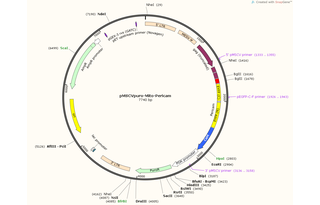-
PurposeRetroviral transfection of cells to express ratiometric Pericam as described by Nagai et al 2001 (PMID 11248055) localising to the mitochondrial matrix via the transit peptide from human COX8A.
-
Depositing Lab
-
Sequence Information
Ordering
| Item | Catalog # | Description | Quantity | Price (USD) | |
|---|---|---|---|---|---|
| Plasmid | 87381 | Standard format: Plasmid sent in bacteria as agar stab | 1 | $85 | |
Backbone
-
Vector backbonepMSCVpuro
-
Backbone manufacturerClontech
- Backbone size w/o insert (bp) 6264
- Total vector size (bp) 7740
-
Vector typeMammalian Expression, Retroviral
-
Selectable markersPuromycin
Growth in Bacteria
-
Bacterial Resistance(s)Ampicillin, 100 μg/mL
-
Growth Temperature37°C
-
Growth Strain(s)NEB Stable
-
Copy numberHigh Copy
Gene/Insert
-
Gene/Insert nameMito-Pericam [ratiometric]
-
Insert Size (bp)1488
- Promoter Retroviral 5' LTR promoter
Cloning Information
- Cloning method Restriction Enzyme
- 5′ cloning site NheI (not destroyed)
- 3′ cloning site EcoRI (not destroyed)
- 5′ sequencing primer pMSCV-F
- 3′ sequencing primer pMSCV-R (Common Sequencing Primers)
Resource Information
-
Supplemental Documents
-
A portion of this plasmid was derived from a plasmid made byRatiometric Pericam: Prof. Jan Parys (KU Leuven, Belgium) & Prof. R. Rizzuto (University of Padova, Italy); as described by Nagai et al 2001 (PMID 11248055), with an enhanced tandem mitochondrial localisation sequence from human COX8A (2mt8-Pericam) as described by Fillipin et al 2005 (PMID 15589993).
-
Articles Citing this Plasmid
Terms and Licenses
-
Academic/Nonprofit Terms
-
Industry Terms
- Not Available to Industry
Trademarks:
- Zeocin® is an InvivoGen trademark.
Depositor Comments
Ratiometric Pericam is a fluorescent [Ca2+] probe consisting of a modified permuted EYFP (i.e. its C- and N-terminus were exchanged and connected by a Gly-rich linker, and the mutations F46L, Q69K, H148D, V163A, S175G, and Y203F were introduced) flanked by Calmodulin (CaM; from X. laevis, identical to UniProt ID P62155 except for D65Y) at the C-terminus and by an M13 peptide (the CaM binding site (K566-L591) of human MYLK2) at the N-terminus. Increase in [Ca2+] leads to binding of CaM to M13 and thus structural changes resulting in a shift of the excitation maximum from ~410 nm to ~495 nm, while the emission peak remains at ~515 nm. The fluorescence intensity ratio of Ex495/Ex410 increases up to tenfold in a [Ca2+]-dependent manner, from 10% at 0.1 µM or lower to 100% at 10 µM or higher.
The two mitochondria transit peptide sequences (purple) are identical to the pre-sequence (M1-L29 and M1-G33, respectively) of human COX8A (UniProt ID P10176).
The M13 peptide sequence (red) is identical to the Calmodulin binding site (K566-L591) of human MYLK2 (Myosin light chain kinase 2; UniProt ID Q9H1R3).
The EYFP sequence (yellow) is identical with the SnapGene EYFP sequence except for F46L, Q69K, H148D, V163A, S175G.
The Calmodulin protein sequence (blue) is identical to that of X. laevis Calmodulin (UniProt ID P62155) except for the mutation D65Y caused by GAC-->TAC.
These plasmids were created by your colleagues. Please acknowledge the Principal Investigator, cite the article in which the plasmids were described, and include Addgene in the Materials and Methods of your future publications.
-
For your Materials & Methods section:
pMSCVpuro-Mito-Pericam was a gift from Björn Stork (Addgene plasmid # 87381 ; http://n2t.net/addgene:87381 ; RRID:Addgene_87381) -
For your References section:
The mycotoxin phomoxanthone A disturbs the form and function of the inner mitochondrial membrane. Bohler P, Stuhldreier F, Anand R, Kondadi AK, Schlutermann D, Berleth N, Deitersen J, Wallot-Hieke N, Wu W, Frank M, Niemann H, Wesbuer E, Barbian A, Luyten T, Parys JB, Weidtkamp-Peters S, Borchardt A, Reichert AS, Pena-Blanco A, Garcia-Saez AJ, Itskanov S, van der Bliek AM, Proksch P, Wesselborg S, Stork B. Cell Death Dis. 2018 Feb 19;9(3):286. doi: 10.1038/s41419-018-0312-8. 10.1038/s41419-018-0312-8 PubMed 29459714






